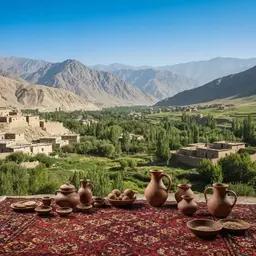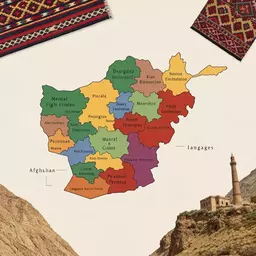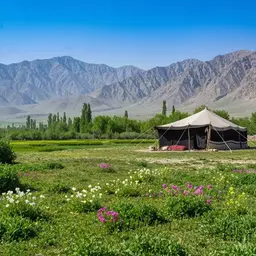Geography's Role in Afghan Culture
By Khalid Rahimi / Nov 19
What if the hidden treasures of Afghanistan could tell you stories beyond the conventional tourist paths? From ancient monuments to breathtaking landscapes, each site offers a unique glimpse into the heart of this remarkable nation, waiting to be explored. Let's dive into the key takeaways from our journey through Afghanistan's lesser-known provincial landmarks.
This visual highlights key categories of Afghanistan's rich cultural heritage, from ancient landmarks to vibrant traditions.
Diverse traditions & customs by province
Historical landmarks reveal societal evolution
Local festivals celebrate vibrant culture
As we journey through the rich tapestry of Afghanistan's geography and culture, it's essential to recognize the cultural significance of its lesser-known sites. These hidden gems not only showcase the historical richness of the country but also reveal the intricate connections between its landscapes and the diverse peoples who inhabit them. From ancient monuments to natural wonders, every site tells a unique story that enhances our understanding of Afghanistan's heritage.
In this exploration, we'll uncover the beauty and significance of these provincial landmarks, setting the stage for a deeper appreciation of what Afghanistan has to offer. Whether you're a traveler, researcher, or simply curious about the culture, these sites invite you to experience the heart and soul of this remarkable nation.
Afghanistan's cultural heritage is as diverse as its geography. The various provinces contribute their own unique threads to the national tapestry, shaped by centuries of history, trade, and interactions among different communities. This rich background makes the country a treasure trove for those interested in both history and culture. For more information on the growing interest in Afghan tourism, you can refer to insights provided by Travel Tomorrow.
By delving into these aspects, we can better appreciate how Afghanistan's geography influences its culture, creating a beautiful blend that captivates anyone willing to explore. Prepare to be amazed as we journey through some of the most fascinating sites beyond the conventional tourist paths!
The Minaret of Jam, standing tall in the heart of the Ghor Province, is not just an architectural marvel; it’s a testament to the historical significance of Afghanistan. Constructed in the 12th century, this UNESCO World Heritage Site is adorned with intricate brickwork and beautiful tile mosaics. As you visit, you can expect to be awed by its towering height and the stunning landscape that surrounds it. The minaret serves as a reminder of the country's Islamic heritage and the artistic skills of its builders.
Once towering over the Bamiyan Valley, the Buddhas of Bamiyan were among the tallest standing statues of the Buddha in the world. Carved into the cliffs, these statues reflect the blend of Afghan and Buddhist traditions long before their destruction in 2001. Today, preservation efforts are ongoing, aiming to honor their historical context while fostering a sense of cultural identity for the local communities. Visiting this site allows you to connect with Afghanistan's deep-rooted history and the resilience of its people.
As one of the oldest cities in Afghanistan, Ghazni boasts a wealth of monuments that tell the story of its glorious past. Once a bustling hub on the ancient Silk Road, Ghazni's architecture and ruins reflect its significance in Afghanistan's development. The city is home to remarkable sites, such as the Ghazni Fortress and various tombs, that attract history enthusiasts eager to uncover the layers of Afghan civilization.
Balkh, often referred to as the "Mother of Cities," is steeped in history and revered as one of the oldest cities in the world. Its significance in the history of trade and culture cannot be overstated, making it a must-visit for anyone interested in Afghanistan's past. The ancient ruins, combined with the vibrant local culture, create a unique atmosphere that invites exploration and discovery.
The Wakhan Corridor is a stunningly beautiful and culturally diverse region that separates Afghanistan from Tajikistan. The scenery here is nothing short of breathtaking, featuring towering mountains and lush valleys. When visiting, you'll encounter a unique blend of cultures, with the Wakhi and Pamiri peoples residing in this remote area. Be prepared to experience their warm hospitality as you explore this remote part of Afghanistan!
The Panjshir Valley is another example of Afghanistan's stunning landscapes, known for its breathtaking views and historical significance. This valley has served as a natural refuge throughout the ages, offering a serene escape for visitors. Nature lovers can enjoy hiking, exploring local wildlife, and immersing themselves in the valley's rich history, while taking in the captivating scenery.
Band-e Amir National Park is a true gem in Afghanistan, celebrated for its remarkable geological formations and vibrant blue lakes. As the country's first national park, it offers a perfect blend of adventure and relaxation. Activities such as hiking, picnicking, and exploring the unique landscapes make this destination a must-visit for anyone traveling through Afghanistan. Don’t forget to capture the stunning views that await!
Mazar-i-Sharif is home to the stunning Blue Mosque, an architectural wonder that reflects the deep spirituality of the region. This mosque is not only a prayer site but also a cultural landmark that plays a significant role in the lives of locals. It attracts pilgrims and visitors alike, who come to admire its intricate designs and experience the local culture.
The Herat Citadel is a symbol of resilience, having withstood the tests of time and conflict. Its impressive architecture and historical context make it an essential stop for anyone interested in Afghan history. For additional insights into the cultural and historical aspects of tourism in Afghanistan, consider this academic paper on Afghan tourism. Visitors can explore the fortress and gain insight into its storied past while enjoying panoramic views of the bustling city below.
In Kandahar, the bazaars are alive with colors, sounds, and scents that reflect the city's rich cultural tapestry. Here, you can explore local mosques, savor traditional dishes, and engage with the hospitality of the Afghan people. Each interaction offers a glimpse into the daily life and customs that define this vibrant region.
Khost Province offers a unique opportunity to experience authentic local life. From traditional crafts to vibrant festivals, this province is rich in cultural experiences that reflect the diversity of Afghanistan. By engaging with the locals, you can gain a deeper understanding of their traditions and lifestyles, making your journey even more meaningful.
Buzkashi is more than just a sport; it’s a significant cultural event that showcases the spirit of Afghanistan. Played on horseback, this traditional game involves teams competing to grab a goat carcass and carry it to a designated goal. The thrill of the game, combined with the enthusiasm of the crowd, makes attending a Buzkashi match an unforgettable experience. It beautifully reflects the local culture and camaraderie among the people.
When visiting Afghanistan, expect to be greeted with warmth and kindness. Afghan hospitality is legendary, with locals eager to share their traditions and stories over a meal or tea. Understanding the customs surrounding hospitality can enrich your travel experience, allowing you to connect deeply with the communities you visit. Embrace these moments, and you'll leave with cherished memories.
Some of Afghanistan's lesser-known historical landmarks include the Minaret of Jam in Ghor Province, the ancient city of Balkh, the historical sites in Ghazni, and the Herat Citadel. These sites offer deep insights into the nation's rich past, from Islamic heritage to Silk Road history.
Afghanistan boasts stunning natural landscapes such as the breathtaking Wakhan Corridor, known for its towering mountains and diverse cultures; the Panjshir Valley, a natural refuge with captivating scenery; and Band-e Amir National Park, famous for its vibrant blue lakes and unique geological formations.
Visitors can experience a rich tapestry of cultural activities, including exploring vibrant bazaars in Kandahar, witnessing the architectural beauty of the Blue Mosque in Mazar-i-Sharif, engaging with authentic local life in Khost Province, and observing traditional events like Buzkashi. Afghan indigenous hospitality is also a highlight, with locals often sharing meals and stories over tea.
Yes, efforts are ongoing to preserve Afghanistan's cultural heritage sites. For example, after the destruction of the Buddhas of Bamiyan, there have been significant preservation efforts to honor their historical context and foster cultural identity. Organizations like UNESCO are also involved in protecting sites such as the Minaret of Jam.
While interest in Afghan tourism is growing, as highlighted by Travel Tomorrow and Wikipedia's overview of tourism in Afghanistan, it is crucial to research current travel advisories and conditions thoroughly before planning a visit. Engaging with local guides and understanding the cultural nuances can enhance safety and the overall experience.
When planning your visit to Afghanistan's lesser-known landmarks, consider hiring a local guide. They can provide invaluable insights into the history and culture of the sites, as well as enhance your overall experience through their personal stories and connections to the area.
Exploring Afghanistan's lesser-known landmarks offers a treasure trove of cultural and historical insights. Each hidden gem tells a unique story, revealing the intricate connections between the land and its people. From the ancient architecture of Balkh to the breathtaking landscapes of the Wakhan Corridor, these sites enrich our understanding of Afghanistan’s profound heritage.
As we journey through these remarkable locations, we encounter not only stunning views but also the warmth and resilience of the Afghan people. Engaging with local traditions and histories enhances our travel experience, inviting us to appreciate the intricate tapestry of Afghan culture. For a broader perspective on tourism within the country, you can refer to Wikipedia's dedicated page on tourism in Afghanistan.
Are you ready to uncover the hidden gems of Afghanistan? I encourage you to travel responsibly and engage meaningfully with the communities you visit. Share your experiences, whether you find yourself wandering through the vibrant bazaars of Kandahar or standing in awe of the Buddhas of Bamiyan. Your stories will not only enrich your journey but also inspire others to explore this captivating country.
Let your curiosity guide you as you embark on this adventure. Together, we can illuminate the richness of Afghanistan’s lesser-known landmarks and share the stories that deserve to be told!
Here is a quick recap of the important points discussed in the article:

 Geography's Role in Afghan Culture
In the intricate tapestry of Afghanistan, geography plays a pivotal role in shaping cultural identit
Geography's Role in Afghan Culture
In the intricate tapestry of Afghanistan, geography plays a pivotal role in shaping cultural identit
 Understanding Afghanistan’s Provincial Demographics
Engaging with the intricate demographics of Afghanistan reveals how deeply culture and identity shap
Understanding Afghanistan’s Provincial Demographics
Engaging with the intricate demographics of Afghanistan reveals how deeply culture and identity shap
 Visiting Afghanistan: Seasonal Travel Tips
When planning your journey to Afghanistan, understanding the climate and timing of your visit is cru
Visiting Afghanistan: Seasonal Travel Tips
When planning your journey to Afghanistan, understanding the climate and timing of your visit is cru